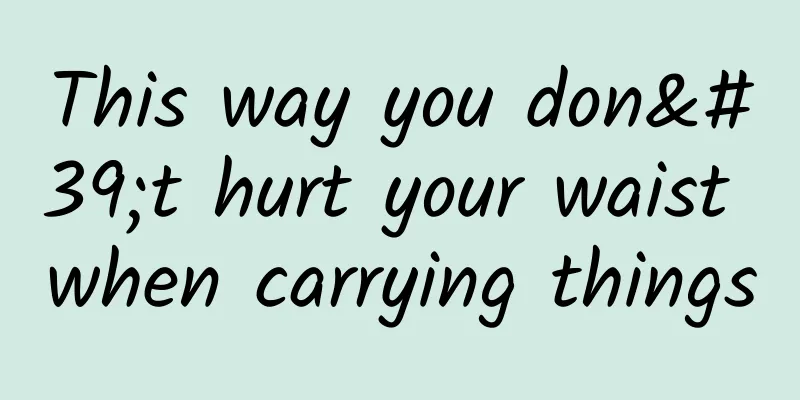This way you don't hurt your waist when carrying things

|
This is the 3761th article of Da Yi Xiao Hu Aunt Wang, an old retired Party member at home, is well-known for her warm-heartedness in the community. Recently, as the epidemic in Shanghai was severe, Aunt Wang actively responded to the call of the Municipal Party Committee, showed her identity, set an example, and took the initiative to join the community's volunteer team. She was elected as the leader of the Party group of the volunteer team. Aunt Wang immediately felt that a heavy responsibility was on her shoulders. She maintained order during nucleic acid testing, went door to door when distributing antigens, and moved 50-pound boxes like a young man when distributing supplies. As a result, she had back pain the next day and couldn't get out of bed. In fact, Aunt Wang's situation is not an isolated case. Just a few days after Aunt Wang fell, several young people in the community who were full of energy had to suspend their volunteer work due to back pain. Many young people on the Internet joke that they are "moving bricks" at work, but moving bricks is a "technical job" with a high threshold. So how can we move things without hurting our backs? We must pay attention to the following points. #01 — Think twice before moving — This is the most important and most easily overlooked. As the saying goes, "One strength can defeat ten skills." As long as the things you move are beyond your ability to bear, you will get hurt even if you move them in the right posture. You must make good use of tools and equipment and ask for help from others. Don't try to be stubborn. It's better to run a few more times than to add more weight than you can bear. If you just move a bag of rice or a box of water and cause an acute attack of lumbar disc herniation or lumbar compression fracture, it will be more trouble than gain. #02 — Stand up properly — Well begun is half done, and most injuries when moving things occur when standing up. When standing up, do not bend over to move, but squat down to move. The specific posture is: spread your feet apart, squat down, straighten your waist, tighten your abdomen, and stand up steadily without being too strong. #03 — Make the center of gravity of the object close to you — Many people are afraid that the surface of objects may carry viruses, so they don't want to let their clothes touch the objects. Instead, they carry the materials with one hand or hold them in their hands. This is actually very harmful to the waist. Carrying heavy objects with one hand will shift the center of gravity, uneven force on the lumbar spine, and increase the risk of lumbar muscle strain and lumbar disc herniation. Holding is more laborious than carrying, and because the lever is longer, the waist is under greater pressure from leaning forward. Therefore, it is recommended to disinfect the outer surface of the object and let the center of gravity of the object close to yourself before carrying it. #04 — Remember to keep your back straight — Bending over will cause unbalanced force on the intervertebral disc, making the lumbar disc bear a backward squeezing force. When carrying weight, it will multiply the burden on the lumbar spine. Therefore, be sure to keep your back straight when moving things. #05 — Don't twist your waist or tilt your back — Similar to the principle of straightening the back, twisting the waist or tilting the back will cause unbalanced force on the intervertebral disc, making the lumbar disc bear a lateral squeezing force, which will multiply the burden on the lumbar spine when carrying weight. #06 — Pushing is better than pulling when moving large items — When moving large items, you will need to use a cart. Pushing a cart is more labor-saving and more ergonomic than pulling a cart. Pulling a cart requires walking backwards, has a large blind spot and is easy to bump into people. It is laborious to go uphill and is more likely to cause safety accidents when going downhill. Therefore, be sure to use a "push" cart when moving large items. #07 — Put down the heavy objects first, then adjust the position — When putting heavy objects down, it is inevitable that you will need to adjust the position. Be sure to put the heavy objects down first and then adjust the position. You may need to bend over or tilt your back during the process of putting down the heavy objects. This will put a lot of pressure on your waist and it is easy to damage your lumbar spine and waist muscles. Therefore, you should put the heavy objects down first and then adjust the position. These are seven tips for lifting heavy objects without hurting your waist. Have you learned it? Author: Putuo Hospital Affiliated to Shanghai University of Traditional Chinese Medicine Department of Orthopedics Yu Luchao Attending Physician |
Recommend
Do uterine polyps require surgery?
Uterine polyps are common gynecological diseases ...
What's the matter with the pain down there?
Women are always troubled by some vaginal disease...
Can I keep a cat during pregnancy?
The early stage of pregnancy is about three month...
Can girls eat oranges during menstruation?
Oranges are very nutritious and have certain bene...
How to treat lower body odor effectively
In summer, if a woman has a strong odor from her ...
What to do if you have joint pain after abortion
Nowadays, people born in the 1980s and 1990s do n...
Can I take a bath during my period? What should I pay attention to?
Some female friends do not pay attention to their...
What causes urinary tract infection in women?
Urinary tract infection is a disease that many pe...
How many days does it take for ovulation bleeding to stop?
It is normal for ovulation to be accompanied by b...
Solutions for menstrual breast pain
Menstrual breast pain is a manifestation of irreg...
Is it dangerous to have a baby? Worried about the baby being unhealthy? Is freezing eggs advisable? Solving the fertility problems of "older" women
The sudden gossip about celebrities in the entert...
What are the dangers of strenuous exercise during menstruation?
When women have their period, they will experienc...
Bright red blood
Female friends should have a certain understandin...
Why is it easy to get angry after moxibustion? What should I do if I get angry after moxibustion during the dog days?
Moxibustion usually causes internal heat in peopl...









